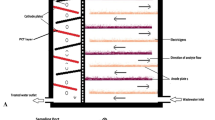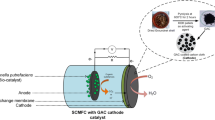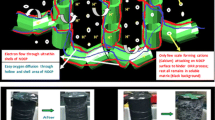Abstract
An air-cathode microbial fuel cell (MFC) was implemented to examine the cathode material: bismuth ferrite (BFO) nanoparticles mixed with carbon soot. The physicochemical characterization of prepared carbon soot showed that the carbon soot particles were porous and graphitic consisting of 88% carbon. The physicochemical characterization of BFO confirms that the nanoparticles are spherical, have a high surface area, and are electrochemically active. Based on the results of the linear sweep voltammetry (LSV) examination, the large surface area of BFO has been accounted for by high ORR (oxidation–reduction reaction) activities. The increasing loading rates of BFO (0.25–1 mg/cm2) showed increasing power output, with 1 mg/cm2 achieving the maximum power density and current density (11.99 W/m3 and 35.45 A/m3, respectively), which were comparable to the power output of platinum. According to electrochemical impedance spectroscopy (EIS) analysis, BFO showed the lowest resistance (Rct) across each electrode transmission (39.5) at a loading rate of 1 mg/cm2. This low Rct value indicates that the cathode catalyst facilitates high electron transfer, thereby increasing the cathode's ORR activity. The cathode biofouling analysis for different concentrations of BFO conducted via confocal laser scanning microscopy (CLSM) showed that 1.0 mg/cm2 BFO showed the least biofouling. The results of the research suggest that BFO-blended carbon soot has potential as a cost-effective alternative for field-scale usage.












Similar content being viewed by others
References
S.R. Sharvini, Z.Z. Noor, C.S. Chong, L.C. Stringer, and R.O. Yusuf, Energy consumption trends and their linkages with renewable energy policies in East and Southeast Asian countries: challenges and opportunities. Sustain. Environ. Res. 28, 257 (2018).
B.E. Logan, Microbial Fuel Cells (Hoboken: Wiley, 2008).
D.A. Jadhav, A.A. Carmona-Martínez, A.D. Chendake, S. Pandit, and D. Pant, Modeling and optimization strategies towards performance enhancement of microbial fuel cells. Biores. Technol. 320, 124256 (2021).
A.J. Slate, K.A. Whitehead, D.A.C. Brownson, and C.E. Banks, Microbial fuel cells: an overview of current technology. Renew. Sustain. Energy Rev. 101, 60 (2019).
A.S. Mathuriya and J.V. Yakhmi, Microbial fuel cells - Applications for generation of electrical power and beyond. Crit. Rev. Microbiol. 42, 127 (2016).
H. Moon, I.S. Chang, and B.H. Kim, Continuous electricity production from artificial wastewater using a mediator-less microbial fuel cell. Biores. Technol. 97, 621 (2006).
K. Rabaey and W. Verstraete, Microbial fuel cells: novel biotechnology for energy generation. Trends Biotechnol. 6, 291 (2005).
A.E. Franks and K.P. Nevin, Microbial fuel cells, a current review. Energies 3, 899 (2010).
K. Zhong, M. Li, Y. Yang, H. Zhang, and B. Zhang, Nitrogen-doped biochar derived from watermelon rind as oxygen reduction catalyst in air cathode microbial fuel cells. Appl. Energy 242, 516 (2019).
S. Khilari, S. Pandit, M.M. Ghangrekar, D. Das, and D. Pradhan, Graphene supported α-mnO2 nanotubes as a cathode catalyst for improved power generation and wastewater treatment in single-chambered microbial fuel cells. RSC Adv. 3, 7902 (2013).
J. Ahmed, Y. Yuan, L. Zhou, and S. Kim, Experimental and computational analyses of thermal runaway behavior of lithium ion pouch battery at low ambient pressure. J. Power Sour. 208, 170 (2012).
S. Liu, R. Wang, C. Ma, D. Yang, and D. Li, Low-temperature synthesis of small-sized high-entropy oxides for water oxidation. Chem. Eng. J. 7, 123627 (2019).
S. You, N. Ren, Q. Zhao, J. Wang, and F. Yang, Fuel Cells 9, 588 (2009).
G.D. Bhowmick, S. Das, M.M. Ghangrekar, A. Mitra, and R. Banerjee, J. Inst. Eng. (India) Ser. A 100, 675 (2019).
J. Shanthi Sravan, T.S.K. Raunija, A. Verma, and S. Venkata Mohan, Impregnated thermoset pre-pressurized carbon composite electrodes in microbial fuel cell Compositional functionalities influence on ORR with reference to graphite. Fuel 285, 119273 (2021).
S. Karthick, S. Vishnuprasad, K. Haribabu, and N. manju, Activated carbon derived from ground nutshell as a metal-free oxygen reduction catalyst for air cathode in single chamber microbial fuel cell. Biomass Convers. Biorefinery 12, 1729 (2021).
C. Gao, L. Liu, T. Yu, and F. Yang, Synergistic effect of well-defined dual sites boosting the oxygen reduction reaction. J. Membr. Sci. 549, 533 (2018).
X. Li, Y. Lin, Y. Yang, W. Zhang, M. Hu, Y. Zhong, Y. Liao, and W. Li, Defective metal-organic frameworks: current status and perspectives. Electrochim. Acta 391, 138922 (2021).
S. Khilari, S. Pandit, J.L. Varanasi, D. Das, and D. Pradhan, Appl. Mater. Interfaces 7, 20657–20666 (2015).
I. Das, T. Noori, G. Dhar, and M.M. Ghangrekar, Bismuth doped TiO2 as an excellent photocathode catalyst to enhance the performance of microbial fuel cell. Int. J. Hydrogen Energy 43, 7501–7510 (2018).
B. Zhang, D. Wang, B. Yu, F. Zhou, and W. Liu, Candle soot as a supercapacitor electrode material. RSC Adv. 4, 2586 (2014).
Z. Wei, K. Yan, H. Chen, Y. Yi, T. Zhang, X. Long, J. Li, L. Zhang, J. Wang, and S. Yang, Cost-efficient clamping solar cells using candle soot for hole extraction from ambipolar perovskites. Energy Environ. Sci. 7, 3326–3333 (2014).
S. Singh, P.K. Bairagi, and N. Verma, Candle soot-derived carbon nanoparticles: an inexpensive and efficient electrode for microbial fuel cells. Electrochim. Acta 264, 119 (2018).
B.-Y. Chen, Y.-T. Tsao, and S.-H. Chang, Cost-effective surface modification of carbon cloth electrodes for microbial fuel cells by candle soot coating. Coatings 8, 468 (2018).
S. Li, J. Jiang, S.-H. Ho, F. Li, and W. Zeng, Bimetallic nitrogen-doped porous carbon derived from ZIF-L&FeTPP@ZIF-8 as electrocatalysis and application for antibiotic wastewater treatment. Sep. Purif. Technol. 276, 119259 (2021).
M. Khan, J. Shukla, P. Saxena, A. Mishra, and P. Sharma, Evaluation of structural and multifunctional properties of BaTiO3–NiFe2–xSmxO4 ceramic composites. Appl. Phys. A 128, 1120 (2022).
M.V. Kannan and G. Gnana Kumar, Current status, key challenges and its solutions in the design and development of graphene based ORR catalysts for the microbial fuel cell applications. Biosens. Bioelectron. 77, 1208 (2016).
A. Kumar, A. Kumar, S. Tyagi, R. Chandra, and D. Kaur, Room temperature tunability of ferroelectricity and dielectricity in La and Mn codoped BiFeO3 nanoflakes: implications for electronic devices applications. Ceram. Int. 49, 1960 (2023).
S. P. Jung and S. Pandit, Chapter 3.1 - Important Factors Influencing Microbial Fuel Cell Performance, in Microbial Electrochemical Technology, 377-406 (Elsevier, 2019).
F. Qin and C. Brosseau, A review and analysis of microwave absorption in polymer composites filled with carbonaceous particles. J. Appl. Phys. 111, 061301 (2012).
P. Fischer, M. Polomska, I. Sosnowska, and M. Szymanski, Temperature dependence of the crystal and magnetic structures of BiFeO3. J. Phys. C: Solid State Phys. 13, 1931 (1980).
V. Raghavan, Materials Science and Engineering: A First Course (Delhi: PHI Learning Pvt. Ltd., 2015).
D. Tian, H. Zhou, H. Zhang, P. Zhou, J. You, G. Yao, Z. Pan, Y. Liu, and B. Lai, Heterogeneous photocatalyst-driven persulfate activation process under visible light irradiation: from basic catalyst design principles to novel enhancement strategiesChemical. Eng. J. 428, 131166 (2022).
F. Mushtaq, X. Chen, M. Hoop, H. Torlakcik, E. Pellicer, J. Sort, C. Gattinoni, B.J. Nelson, and S. Pané, iScience 4, 236 (2018).
G. Catalan and J.F. Scott, Physics and applications of bismuth ferrite. Adv. Mater. 21, 2463 (2009).
A. Reyes, C. de la Vega, M.E. Fuentes, and L. Fuentes, BiFeO3: Synchrotron radiation structure refinement and magnetoelectric geometry. J. Eur. Ceram. Soc. 27, 3709 (2007).
S.M. Lam, J.C. Sin, H. Zeng, H. Lin, H. Li, A.R. Mohamed, and J.W. Lim, Ameliorating Cu2+ reduction in microbial fuel cell with Z-scheme BiFeO3 decorated on flower-like ZnO composite photocathode. Chemosphere 287, 132384 (2022).
M.-A. Shahbazi, L. Faghfouri, M.P.A. Ferreira, P. Figueiredo, H. Maleki, F. Sefat, H. Jouni, and H.A. Santos, The versatile biomedical applications of bismuth-based nanoparticles and composites: therapeutic, diagnostic, biosensing, and regenerative properties. Chem. Soc. Rev. 49, 1253 (2020).
Y. Zhang, Y. Hu, S. Li, J. Sun, and B. Hou, Manganese dioxide-coated carbon nanotubes as an improved cathodic catalyst for oxygen reduction in a microbial fuel cell. J. Power Sour. 196, 9284 (2011).
S.M. Lam, Z.H. Jaffari, J.C. Sin, H. Zeng, H. Lin, H. Li, and A.R. Mohamed, Insight into the influence of noble metal decorated on BiFeO3 for 2, 4-dichlorophenol and real herbicide wastewater treatment under visible light. Coll. Surf. A Physicochem. Eng. Aspects 614, 126138 (2021).
P. Dange, N. Savla, S. Pandit, R. Bobba, S.P. Jung, P.K. Gupta, M. Sahni, and R. Prasad, A comprehensive review on oxygen reduction reaction in microbial fuel cells. J. Renew. Mater. 10, 665 (2022).
O.O. Kolajo, C. Pandit, B.S. Thapa, S. Pandit, A.S. Mathuriya, P.K. Gupta, D.A. Jadhav, D. Lahiri, M. Nag, and V.J. Upadhye, Impact of cathode biofouling in microbial fuel cells and mitigation techniques. Biocatal. Agric. Biotechnol. 43, 102408 (2022).
T. Pema, A. Kumar, B. Tripathi, S. Pandit, S. Chauhan, S. Singh, P.K. Dikshit, A.S. Mathuriya, P.K. Gupta, D. Lahiri, R.C. Singh, J. Anand, and K.K. Chaubey, Investigating the performance of lithium-doped bismuth ferrite -graphene nanocomposites as cathode catalyst for the improved power output in microbial fuel cells. Catalysts 13, 618 (2023).
K. Biswas, D. De, J. Bandyopadhyay, N. Dutta, S. Rana, P. Sen, S.K. Bandyopadhyay, and P.K. Chakraborty, Enhanced polarization, magnetic response and pronounced antibacterial activity of bismuth ferrite nanorods. Mater. Chem. Phys. 195, 207 (2017).
C. Rameshkumar, R. Gayathri, and R. Subalakshmi, Synthesis and characterization of undopped bismuth ferrite oxide nanoparticles for the application of cancer treatment. Mater. Today Proc. 43, 3662 (2021).
C. Claudio and S. Chellam, Bismuth Nanoparticles : Antimicrobials of Broad-Spectrum , Low Cost and Safety Outline : (Nanomedicine, 2014).
Z. Haider, S. Lam, J. Sin, and H. Zeng, Boosting visible light photocatalytic and antibacterial performance by decoration of silver on magnetic spindle-like bismuth ferrite. Mater. Sci. Semicond. Process. 101, 103 (2019).
T.O. Ajiboye, O.A. Oyewo, and D.C. Onwudiwe, he performance of bismuth-based compounds in photocatalytic applications. Surf. Interfaces 23, 100927 (2021).
P. Chatterjee and M.M. Ghangrekar, Design of clayware separator-electrode assembly for treatment of wastewater in microbial fuel cells. Appl. Biochem. Biotechnol. 173, 378 (2014).
A. Vempaty and A.S. Mathuriya, Strategic development and performance evaluation of functionalized tea waste ash-clay composite as low-cost, high-performance separator in microbial fuel cell. Environ. Technol. 44, 2713 (2022).
B.E. Logan, B. Hamelers, R. Rozendal, U. Schröder, J. Keller, S. Freguia, P. Aelterman, W. Verstraete, and K. Rabaey, Microbial fuel cells: methodology and technology. Environ. Sci. Technol. 40, 5181 (2006).
M. Djellali, M. Kameche, H. Kebaili, M. Mustapha, and A. Benhamou, Synthesis of nickel-based layered double hydroxide (LDH) and their adsorption on carbon felt fibres: application as low cost cathode catalyst in microbial fuel cell (MFC). Environ. Technol. 42, 492 (2021).
A.D. Pathak and C.S. Sharma, Candle soot carbon cathode for rechargeable Li-CO2-Mars battery chemistry for Mars exploration: a feasibility study. Mater. Lett. 283, 128868 (2021).
R. Kanakaraj and C. Sudakar, Candle soot carbon nanoparticles as high-performance universal anode for M-ion (M = Li+, Na+ and K+) batteries. J. Power Sour. 458, 228064 (2020).
T. Ghosh, R. Ghosh, U. Basak, S. Majumdar, R. Ball, D. Mandal, A.K. Nandi, and D.P. Chatterjee, Candle soot derived carbon nanodot/polyaniline hybrid materials through controlled grafting of polyaniline chains for supercapacitors. J. Mater. Chem. A 6, 6476 (2018).
C.J. Raj, B.C. Kim, B.-B. Cho, W.-J. Cho, S.-J. Kim, S.Y. Park, and K.H. Yu, Electrochemical supercapacitor behaviour of functionalized candle flame carbon soot. Bull. Mater. Sci. 39, 241 (2016).
V.K. Bharti, A. Gangadharan, S.K. Kumar, A.D. Pathak, and C.S. Sharma, Protective interlayer for trapping polysulfides and conducting host for sulfur: dual role of candle soot carbon for the development of high performance Lithium–Sulfur battery. Mater. Adv. 2, 3031 (2021).
Y. Hung, T. Liu, and H. Chen, Renewable coffee waste-derived porous carbons as anode materials for high-performance sustainable microbial fuel cells. ACS Sustain. Chem. Eng. 7, 16991 (2019).
A. Kumar and D. Varshney, Crystal structure refinement of Bi1− xNdxFeO3 multiferroic by the Rietveld method. Ceram. Int. 38, 3935 (2012).
L.V. Costa, R.C. Deus, C.R. Foschini, E. Longo, M. Cilense, and A.Z. Simões, Experimental evidence of enhanced ferroelectricity in Ca doped BiFeO3. Mater. Chem. Phys. 144, 476–483 (2014).
X. Wang, Y. Zhang, and Z. Wu, Magnetic and optical properties of multiferroic bismuth ferrite nanoparticles by tartaric acid-assisted sol–gel strategy. Mater. Lett. 3, 486–488 (2010).
R. Haumont, J. Kreisel, P. Bouvier, and F. Hippert, Phonon anomalies and the ferroelectric phase transition in multiferroic BiFeO3. Phys. Rev. B 73, 2 (2006).
R. Sankar Ganesh, S.K. Sharma, S. Sankar, B. Divyapriya, E. Durgadevi, P. Raji, S. Ponnusamy, C. Muthamizhchelvan, Y. Hayakawa, and D.Y. Kim, Microstructure, structural, optical and piezoelectric properties of BiFeO3 nanopowder synthesized from sol–gel. Curr. Appl. Phys. 17, 409–416 (2017).
J.R. Kim, J.-Y. Kim, S.-B. Han, K.-W. Park, G.D. Saratale, and S.-E. Oh, Application of Co-naphthalocyanine (CoNPc) as alternative cathode catalyst and support structure for microbial fuel cells. Biores. Technol. 102, 342 (2011).
E. HaoYu, S. Cheng, K. Scott, and B. Logan, Microbial fuel cell performance with non-Pt cathode catalysts. J. Power Sour. 171, 275 (2007).
S. Khilari, S. Pandit, D. Das, and D. Pradhan, Manganese cobaltite/polypyrrole nanocomposite-based air-cathode for sustainable power generation in the single-chambered microbial fuel cells. Biosens. Bioelectron. 54, 534 (2014).
S. Rout, A.K. Nayak, J.L. Varanasi, D. Pradhan, and D. Das, Enhanced energy recovery by manganese oxide/reduced graphene oxide nanocomposite as an air-cathode electrode in the single-chambered microbial fuel cell. J. Electroanal. Chem. 815, 1 (2018).
M.R. Majidi, F. Shahbazi Farahani, M. Hosseini, and I. Ahadzadeh, Low-cost nanowired α-MnO2/C as an ORR catalyst in air-cathode microbial fuel cell. Bioelectrochemistry 125, 38 (2019).
Z.H. Jaffari, S.-M. Lam, J.-C. Sin, and H. Zeng, Boosting visible light photocatalytic and antibacterial performance by decoration of silver on magnetic spindle-like bismuth ferrite. Mater. Sci. Semicond. Process. 101, 103 (2019).
M. Sharmila, R.J. Mani, C. Parvathiraja, S.M.A. Kader, M.R. Siddiqui, S.M. Wabaidur, M.A. Islam, and W.-C. Lai, Visible light photocatalyst and antibacterial activity of BFO (Bismuth Ferrite) nanoparticles from honey. Water 14, 1545 (2022).
Y. Yang, J.Y. Sun, K. Zhu, Y.L. Liu, and L. Wan, Structure properties of BiFeO3 films studied by micro-Raman scattering. J. Appl. Phys. 103, 093532 (2008).
G.D. Bhowmick, S. Das, K. Adhikary, M.M. Ghangrekar, and A. Mitra, Using rhodium as a cathode catalyst for enhancing performance of microbial fuel cell. Int. J. Hydrogen Energy 44, 22218 (2019).
F. Zhang, S. Cheng, D. Pant, G. Van Bogaert, and B.E. Logan, Power generation using an activated carbon and metal mesh cathode in a microbial fuel cell. Electrochem. Commun. 11, 2177 (2009).
G.D. Bhowmick, S. Das, H.K. Verma, B. Neethu, and M.M. Ghangrekar, Improved performance of microbial fuel cell by using conductive ink printed cathode containing Co3O4 or Fe3O4. Electrochim. Acta 310, 173 (2019).
I. Das, S. Das, and M.M. Ghangrekar, Application of bimetallic low-cost CuZn as oxygen reduction cathode catalyst in lab-scale and field-scale microbial fuel cell. Chem. Phys. Lett. 751, 137536 (2020).
G.D. Bhowmick, M.T. Noori, I. Das, B. Neethu, M.M. Ghangrekar, and A. Mitra, Bismuth doped TiO2 as an excellent photocathode catalyst to enhance the performance of microbial fuel cell. Int. J. Hydrogen Energy 43, 7501 (2018).
S. Chauhan, A. Kumar, S. Pandit, A. Vempaty, M. Kumar, B.S. Thapa, N. Rai, and S.G. Peera, Investigating the performance of a zinc oxide impregnated polyvinyl alcohol-based low-cost cation exchange membrane in microbial fuel cells. Membranes 13, 55 (2023).
Acknowledgments
Grants from Mahatma Gandhi Central University and the Sharda University seed grant initiative (SUSF2001/01) and Industrial Project Grant (SU/SF/2023/25) are gratefully acknowledged by the authors. The Life Sciences Research Board, the Defence Research and Development Organization (DRDO) (File No. LSRB/81/48222/LSRB-368/BTB/2020), and the Department of Science and Technology (File No. CRD/2018/000022) all provided funding for the completion of this work, which the authors gladly acknowledge.
Author information
Authors and Affiliations
Contributions
Conceptualization: SP, ASM, MS; Experiment: AV, ASM, SP, and MS; writing—original draft preparation; AV, SP, MS, ASM, and MS; writing—review; RP, ASM, MS, SC, AKR, and SP: editing; SC, SP, CP, ASM, and RP; supervision: MS, RP, and ASM. The published version of the work has been reviewed and approved by all authors.
Corresponding authors
Ethics declarations
Conflict of interest
The authors declare that they have no conflict of interest.
Additional information
Publisher's Note
Springer Nature remains neutral with regard to jurisdictional claims in published maps and institutional affiliations.
Rights and permissions
Springer Nature or its licensor (e.g. a society or other partner) holds exclusive rights to this article under a publishing agreement with the author(s) or other rightsholder(s); author self-archiving of the accepted manuscript version of this article is solely governed by the terms of such publishing agreement and applicable law.
About this article
Cite this article
Vempaty, A., Sahni, M., Pandit, C. et al. Bismuth Ferrite Nanoparticle-Blended Carbon Soot-Based Cathode for Enhanced Power Production in Microbial Fuel Cell. J. Electron. Mater. 53, 106–120 (2024). https://doi.org/10.1007/s11664-023-10757-4
Received:
Accepted:
Published:
Issue Date:
DOI: https://doi.org/10.1007/s11664-023-10757-4




